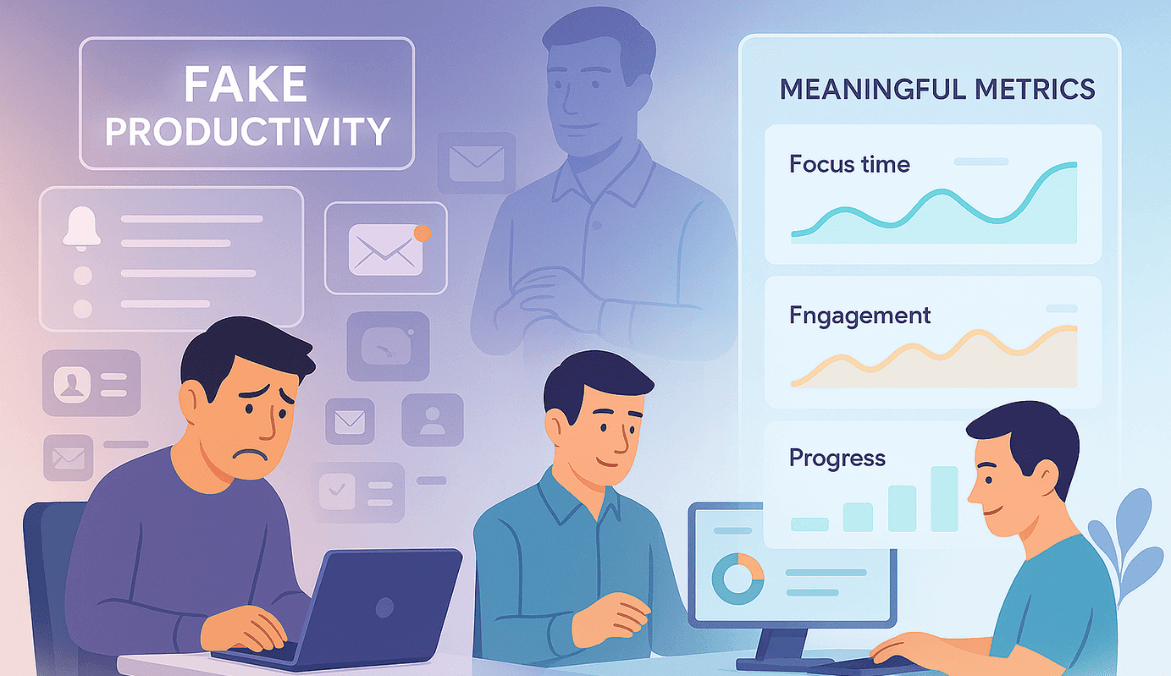Introduction
If you’ve ever walked past a busy office or scrolled through your team dashboard and thought, “Everyone looks active — so why aren’t we moving faster?”, you’ve probably seen fake productivity in action.
Fake productivity isn’t laziness. It’s the illusion of progress — when people appear busy, attend every meeting, and send dozens of updates, yet little real work gets done.
In over two decades of working with organizations of every shape and size, I’ve learned that fake productivity hides in plain sight. It thrives in workplaces where “looking busy” is rewarded more than “creating impact.
In this guide, we’ll unpack what fake productivity really is, why it happens, how to spot it early, and — most importantly — how to fix it without killing morale.
What Is Fake Productivity?
Fake productivity is when activity masquerades as achievement. It’s not that employees aren’t working — they’re just not working on what matters most.
It shows up everywhere:
- The endless meetings that end with “Let’s circle back.”
- The employees who stay late to “look dedicated” but produce the same output.
- The remote worker constantly toggling between apps to appear active online.
In simple terms, fake productivity is motion without progress.
A well-known example: Wells Fargo recently fired several employees for using mouse-mover devices to simulate computer activity — a modern form of performance theatre that fooled no one in the end.
Fake productivity hurts twice: it wastes time and hides the real performance problems beneath surface-level busyness.
Why Fake Productivity Happens
Cultural and Organizational Drivers
In many companies, the culture unconsciously rewards the appearance of effort over results. Long hours, late emails, and constant updates get praised — even when outcomes don’t change.
“Early in my career, I worked with a tech firm where managers valued visibility over value. People spent more time updating dashboards than solving client issues. That’s when I realized fake productivity isn’t about laziness — it’s about misaligned incentives.”
When leadership tracks inputs (like time spent) instead of outputs (like value delivered), employees naturally learn to “perform” productivity.
Technological & Remote Work Factors
Tools meant to improve collaboration can also fuel distraction. Chat pings, real-time notifications, and “online” indicators create pressure to look available rather than stay focused.
That’s how digital presenteeism — being visible online but mentally elsewhere — becomes the new form of fake productivity.
Personal & Psychological Causes
Not all fake productivity is intentional. Sometimes it’s a coping mechanism.
When employees lack clarity or recognition, they fill time with low-value tasks to feel useful. Burnout, fear of underperformance, and poor feedback loops reinforce the cycle.
Signs and Signals of Fake Productivity
Fake productivity leaves clues — you just have to know where to look.
Behavioural Signs
- Endless meetings that don’t lead to action.
- Last-minute “work marathons” before deadlines.
- Colleagues who are always available yet rarely finish meaningful tasks.
Data-Based Signals
Modern productivity analytics make invisible trends visible:
- High idle-time spikes during core hours.
- Frequent context switching — dozens of app changes per hour.
- Long “active time” with minimal measurable output.
- Increased after-hours activity that doesn’t improve results.
When motion outpaces impact, you’re looking at fake productivity in data form.
How to Detect Fake Productivity
Technology helps — but only when paired with transparency and context.
Use Analytics to See Patterns, Not People
Employee monitoring platforms can surface signals such as:
- Excessive app switching (fragmented focus).
- Unusual idle periods despite long log-ins.
- Inconsistent output compared to activity time.
“One pattern I noticed during a client audit — employees logged nine hours of ‘active time,’ but app-switch data showed constant toggling between chat and email. After scheduling focus blocks, the team’s output jumped by 25 % without extending hours.”
The goal isn’t to spy — it’s to spot inefficiencies and coach better habits.
Blend Quantitative and Qualitative Checks
Combine analytics with one-on-one conversations. A rise in idle time may reveal tool fatigue or poor workflow design, not disengagement.
Adopt Ethical Monitoring Practices
Transparency matters. According to a ExpressVPN survey, about 74% of companies use employee monitoring software; among them, 62% log web activity and 59% capture screens in real time — yet employees report higher trust when told exactly what’s being tracked.
If you use a tool like Mera Monitor, blur screenshots, anonymize sensitive data, and let employees view their own dashboards. When people understand why data is collected, they use it to improve themselves.
How to Fix Fake Productivity (Step-by-Step)
Step 1 — Redefine What You Measure
Shift focus from time spent to value created.
Track outcome metrics such as resolved tickets, completed deliverables, and customer impact.
Step 2 — Redesign Work for Focus
Reduce recurring meetings, protect focus hours, and set “quiet times” where notifications are paused so deep work can happen.
Step 3 — Deploy Ethical Monitoring Tools
Use monitoring data to identify patterns, not problems.
Encourage self-review through dashboards so employees can recognize their own habits.
Step 4 — Coach Using Data, Not Control
“When I guided a distributed team through this exact reset, transparency made all the difference. Once employees could see their own metrics, fake activity dropped within weeks — and engagement scores improved dramatically.”
Step 5 — Recognize Real Impact
Reward meaningful progress and measurable outcomes — not performative busyness.
Disengagement remains one of the biggest hidden drains on business performance. Gallup’s 2024 State of the Global Workplace Report found that global employee engagement fell two points to 21%, costing the world economy $438 billion in lost productivity.
Engaged employees consistently deliver stronger business outcomes — higher quality, better retention, and greater profitability. When leaders focus on purpose-driven metrics instead of “hours logged,” they unlock motivation and protect both morale and margins.
Metrics & KPIs That Reflect Real Productivity
To keep momentum, measure what actually moves results:
- Focus Hours: uninterrupted, high-value time.
- Cycle Time: average task completion speed.
- Output Quality: fewer reworks, more results.
- After-Hours Ratio: healthy balance indicates efficiency.
At the same time, monitor early warning signs — rising idle percentages, excessive meetings, and mounting digital noise.
Conclusion
Fake productivity isn’t just a technology issue — it’s a leadership one.
You can’t eliminate it by watching harder; you solve it by helping people work smarter.
After 12+ years of watching teams evolve, I can tell you this: the future of productivity belongs to organizations that value clarity over activity.
If you’re ready to replace busywork with real progress, explore how Mera Monitor enables ethical, insight-driven productivity monitoring built on transparency and trust.
FAQs
Yes — it often takes the form of “performance theatre”: staying late, endless meetings, or constant visibility.
By focusing on outcomes, not hours — and sharing monitoring insights so employees can self-adjust.
Yes. Modern analytics distinguish natural vs. artificial input, but disclosure is key to maintaining trust.
Redefine KPIs around outcomes, communicate openly, and use ethical analytics to highlight genuine progress.
 Gift Card ₹999
Gift Card ₹999

